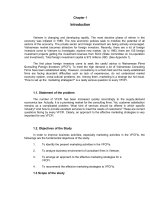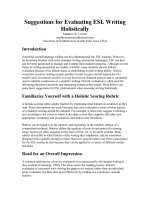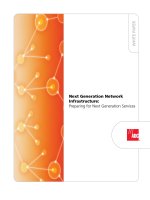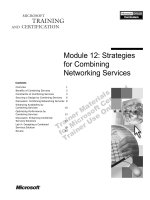Criteria for Evaluating VoIP Service
Bạn đang xem bản rút gọn của tài liệu. Xem và tải ngay bản đầy đủ của tài liệu tại đây (68.22 KB, 10 trang )
4
CRITERIA FOR EVALUATING VoIP
SERVICE1
In this chapter, I describe a set of important criteria that can be used to per-
form qualitative and quantitative measurements of IP phone or POTS phone
(black phone) to black phone/IP phone voice calls over an IP network. Since a
legacy POTS call, with all of its robust characteristics over an IP network, is
considered to be a killer application (service) by many of the proponents of
VoIP, it is recommended that a private IP network or Intranet be used for
measuring performance. This is because the network operator has better con-
trol over the entire network—ingress, egress, routing paths and protocol, and
so on—in such a scenario, and the best possible performance can be achieved
when an internal IP network instead of the public Interent is used for VoIP.
The performance parameters of interest are availability of the network and dial
tone, call setup request processing performance, call completion/drop rate,
one-way voice transport delay or voice envelop delay, voice quality during the
conversation using both subjective and objective measures, and so on. There
is a series (more than 100) of Telcordia LATA switching systems generic
requirements (GRs)—commonly known as LSSGR (details can be found at
www.SAIC.com, 2001)—which specify the reliability, availability, and service
requirements of PSTN switch-based telephony/voice calls. These specifica-
tions may need to be revised in the context of VoIP services o¤ered using next-
generation packet-switch-based multiservice networks.
49
1 The ideas and viewpoints presented here belong solely to Bhumip Khasnabish, Massachusetts,
USA.
SERVICE REQUIREMENTS BEFORE CALL SETUP ATTEMPTS
Two of the most important parameters of interest for VoIP even before a call
setup attempt is made are the following:
Availability of the dial tone so that the users get the impression that the
call-processing host or switch is ready to deliver the service and
Availability of computing and network resources for honoring call pro-
cessing requests. This includes collecting information on the called party’s
identification (e.g., the E.164-based telephone number, e-mail address,
URI/URL), processing this information to determine the best possible
route to set up an RTP/UDP/IP session, and finally, connecting the called
party’s phone to the calling party’s phone.
The traditional PSTN networks have been designed to provide lifeline services
such as processing of emergency or 911 calls. Therefore, in the United States,
PSTN service providers must design their networks to deliver the dial tone to
the customer’s phone 0.30 to 3 sec after the handset is picked up in 95% of in-
stances. This must happen even when the electric power supply is not available.
If VoIP is used for voice transmission service only, it may not be di‰cult to
satisfy this requirement, because the dial tone will still be delivered from a
PSTN switch. However, if VoIP is to be used ETE, including the customer’s
premise equipment—if, for example, an IP phone is used at home instead of a
POTS phone—the access routers and call processing servers must be designed
to satisfy the above-mentioned stringent availability requirements unless the
regulations are relaxed for IP-based real-time voice telephony services.
Next, it is well known [1] that the PSTN network has been designed with
low utilization of transmission and processing resources in mind. That is, the
probability that all of the users who are connected to one PSTN switch will
pick up the phone to make a call at the same time is very low. This may not be
the case for IP networks/protocols that are being experimented with and rede-
signed to support data, voice, and video services. Therefore, when multiple
data- and graphic-sharing sessions are in progress in an IP network, the edge
devices and network may not have enough resources to honor a call processing
request unless a certain amount of these resources are reserved for processing
VoIP calls. This requires the operation of an IP network in overprovisioned or
service-based resource allocation mode, which may not be very cost-e¤ective,
although it is practically achievable.
SERVICE REQUIREMENTS DURING CALL SETUP ATTEMPTS
One of the most important requirements during a VoIP call setup attempt is the
call processing performance, which includes the following two factors:
50
CRITERIA FOR EVALUATING VoIP SERVICE
The total amount of time it takes to set up a call, measured from the
moment the last digit of the first-stage dial-in number—as in multistage
dialing—is entered to the moment the ring-back tone is heard at the call-
originating side. In IP telephony, call setup time can vary from 500 msec to
10 sec, depending on the availability of network and digital signal pro-
cessing (DSP) resources in the system being used. This refers to the call
setup time in an idle system. I discuss these and related issues in Appendix
A.
The number of simultaneous calls that can be handled without any precall
wait. This refers to setting up a call in a busy system. Note that the precall
wait can vary from as little as 1 sec to as much as 10 sec, depending on
the speed of the CPU used in the IP-PSTN GW, availability of memory/
storage and (digital signal) processing resources in the system, and so on.
I discuss these and related issues in Appendix B.
In addition, there may be requirements to support network-level prioritiza-
tion of calls, depending on the number from which the call is originating or the
number for which the call is destined.
It is widely believed that because of sharing of resources and the routed
(instead of switched) nature of connections in operational VoIP networks,
the call processing performance will be, at most, as good as it is in cellular or
wireless networks. In PSTN networks, regional and national call setup time
may vary from @2 to 4 sec (see, e.g., the section on call setup time at www.
att.com/network/standrd.html, 2001), depending on whether or not database
lookup is needed. Note that database lookup is required for credit card–based
calls, toll-free calls, and other types of calls.
According to ITU-T’s E.721 recommendation [2], the average answer-signal
delay (the delay between the time the called party picks up the receiver and the
time the caller receives an indication of this) should be 750 msec for local calls,
1.5 sec for toll calls, and 2.0 sec for international calls, with 1.5, 3.0, and 5.0 sec
as the 95% values, respectively. ITU-T’s E.721 recommendation [2] also states
that the average postdial delay (the interval between dialing the last digit and
hearing the ring-back tone) should be no more than 3 sec for local calls, 5 sec
for toll calls, and 8 sec for international calls, with 95% values of 6, 8, and 11
sec, respectively.
To deliver PSTN-grade call processing performance, the edge devices, ser-
vers, and IP network itself must be designed to be as robust and have as high a
capacity as the PSTN system. This may not yet be very cost-e¤ective to imple-
ment.
SERVICE REQUIREMENTS DURING A VoIP SESSION
After a VoIP session is established, the packetized voice signal must be deliv-
ered from the source (talker) to the destination (listener) in real time without
SERVICE REQUIREMENTS DURING A VoIP SESSION
51
compromising the integrity of the signal. The relevant parameters of interest
are voice coding, processing, envelop delay, packet loss, voice frame packing,
bu¤erring, reconstruction (e.g., delay jittering) strategies, and so on, as dis-
cussed below. The situations become more challenging when one attempts to
make
a. PSTN-hosted advanced services and call features—such as the caller’s
name and identification (ID), call waiting, and three-way call—available
to IP domain clients like PCs and IP phones, and/or
b. IP domain features or Internet-hosted services—such as unified mes-
saging, buddy list and follow-me services, and media conversion and
sharing—available to analog/digital or ISDN phones.
In addition, there is a series of standards (in PSTN) for echo cancellation, bill-
ing, network- and service-level testing and diagnosis, and regulatory function
(e.g., identifying the caller’s location for 911 calls, call tracing and recording
for supporting CALEA, etc.) related requirements. These can be found in var-
ious ITU-T standards documents and in Telcordia’s (www.saic.com/about/
companies/telcordia.html, 2001) LSSGRs.
Voice Coding and Processing Delay
The voice coding and processing delay consists of the delay incurred due to
(a) analog to digital conversion, (b) packetization or framing, (c) packing of
frames, (d) incorporation of error-correction mechanisms, loss- and privacy-
protection mechanisms, and so on of the voice signal at the sender’s end. These
processes are executed in reverse at the receiver’s end, and a similar delay is
incurred there too. These delays are shown in Figure 2-1.
Many of the newly developed low-bit-rate voice coding schemes like ITU-
T’s standards G.723, G.729, and so on are now commonly utilized for VoIP
applications. These schemes utilize advanced memory (or bu¤er) management
and digital signal processing (DSP) techniques to generate low-bit-rate voice
streams, and hence may add significant coding and processing delay. For
example, as discussed in Chapter 2, the coding delay for G.723.1 ACELP
(5.3 Kbps) and G.729 CS-ACELP (8 Kbps) schemes could be as high as
37.5 and 15 msec, respectively, in comparison with zero coding delay for the
G.711 PCM (64 Kbps) coding scheme. Further delay would be incurred when
additional error-correction and loss- and privacy-protection mechanisms are
utilized. As a general rule, for G.711 coding at either the sending or the
receiving network, the coding and all processing delay should not exceed 15%
of the overall mouth-to-ear (M2E) delay. The M2E delay (discussed below)
value recommended by the ITU-T in the G.114 specifications [3] is 150 ms if
one wishes to maintain the toll quality (MOS value of 4.0) of voice. Thus, for
G.711 coding, for ETE VoIP service when the calls are made from one IP
phone to another, the total delay in the access or delivery network should not
52
CRITERIA FOR EVALUATING VoIP SERVICE
exceed 22.5 msec (i.e., 15% of 150 msec). This leaves 105 msec as the maximum
allowable delay (tight upper bound) in the transport or backbone network.
When advanced coding mechanisms (e.g., G.723, G.729) are utilized, the
delay incurred in the receiving or sending network could be as high as 30% of
the 150 msec, and the delay budget for the transport network is reduced to as
little as 60 msec. These scenarios call for deployment of very-high-speed links
in the transport network and operating them at very low short-term utilization
rates.
Voice Envelop Delay
Voice envelop delay is the ETE one-way voice transport delay. The delay—
commonly known as M2E delay—is measured from the moment a noticeable
voice signal appears at the sending end (speaker’s mouth) of a connection to
the moment the same voice signal appears at the receiving end (listener’s ear)
over an established connection. It includes the voice signal framing, packetiza-
tion, and bu¤ering delays at the sending and receiving ends, as well as one-way
network transport (signal propagation and transmission, packet switching,
routing and queueing, etc.) delay.
As shown in Figure 2-1, the one-way network transport delay consists of (a)
switching, routing, and queueing delay at the ingress (access) and egress (deliv-
ery) networks and (b) transport network or transmission delay including signal
propagation delay. As mentioned in the previous section, the general rule is to
keep the one-way transport (or backbone) network delay below 70% (for G.711
coding) of the overall M2E delay (150 msec) recommended by the ITU-T’s
G.114 specification [3] if one wishes to maintain the toll quality (MOS value of
4.0) of voice.
Usually, the ingress and egress network packet transfer delay values are sig-
nificantly less than those in the transport network. This is due to the fact that it
is easy and relatively inexpensive to overengineer the ingress and egress net-
works in order to operate them in overprovisioned mode. The transport net-
work delay is predictable in switched networks like PSTN and ATM networks,
but IP networks like the Internet are routed networks, and they support trans-
mission of a variety of real-time and non-real-time tra‰c over the same net-
work. Consequently, packet queueing and routing delay contribute significantly
to transport network delay even when higher-speed links are deployed, as
discussed in Chapter 2. For example, the time required for transmitting a 128
byte (or a 7 msec sample of G.711 or PCM, encoded voice, as shown in Fig.
2-2) VoIP packet over an idle or lightly utilized 128 Kbps WAN IP link is
[(128 Â 8)/(128 Â 10
3
)] or 8 ms. This delay value can become 15 msec when the
link becomes moderately (@40%) utilized and 50 msec when the link becomes
heavily (@90%) utilized. This is due to the fact that the queues (at both the
ingress and egress of a link) build up very quickly as link utilization increases.
To alleviate this problem, any one or more of the following techniques can be
used: (a) reduce the size of the VoIP packets by using a smaller voice sample
SERVICE REQUIREMENTS DURING A VoIP SESSION
53









